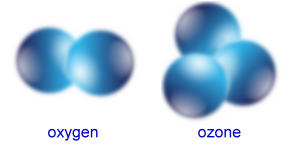What is ozone? Ozone is a naturally occurring gas found in the upper levels of the atmosphere. If you’ve ever noticed a “sweet” smell in the air after a thunder storm, that’s ozone which can be created by lightning.
For the chemistry students out there, oxygen is a gas molecule made up by the combination of two oxygen atoms. You’ve probably heard of it referred to as “O-2”. Ozone is a very “active” form of oxygen gas made up of three oxygen atoms, which is called “O-3.” Because O-3 is less “stable” than O-2, ozone quickly breaks down into regular oxygen.
Ozone has been used for many years as a non-chemical means of treating drinking water because it’s extremely effective at killing microorganisms. Unlike pool chemicals such as chlorine and bromine, ozone doesn’t cause allergic skin reactions, it doesn’t bleach your clothing or hot tub, and it doesn’t have an unpleasant chemical odor.
Besides killing microorganisms, ozone also oxidizes body oils, shampoo, lotions, soap, deodorant, makeup, perfume, and sun tan lotion.
Ozone “re-charges” the chlorine and/or bromine in your hot tub, allowing you to use a lot less caustic chemicals than hot tubs that lack an ozonator.
An ozonator is mounted inside your hot tub walls, and is connected to your spa’s electronics to turn it on and off according to your filter cycle. Using either ultraviolet light or a high energy corona wire, the ozonator coverts oxygen from the air into ozone, which it then injects into your hot tub’s plumbing where it is dispersed into the water. Because ozone is so chemically active, it breaks down quickly into normal oxygen, so the ozonator needs to turn on several times a day. That’s why it’s connected to your hot tub’s electronics pack.
If your hot tub has an ozonator, you can add a mineral sanitizer such as “The Frog” or “Nature 2,” both widely available at your local pool stores. The mineral sanitizer will kill the microorganisms that the ozonator misses. We also recommend the use of a mild chemical sanitizer to help keep your water clean. Monopersulfate (MP) is an excellent alternative to bromine and chlorine. It’s sold under a variety of brands. Usually about 3 ounces every week is good. Make sure you use test strips to check your MP levels.
Finally, you’ll want to help your ozonator and mineral sanitizer with the occassional use of a “shock” agent. We recommend the use of “Dichlor,” which is a concentrated form of chlorine. Use it sparingly, about 1-1/2 ounces every ten days is all you need. The shock will help keep your water clear by dissolving dead bacteria, algae and other contaminants that make your water cloudy.
Do you also have a swimming pool? Many pool owners are tempted to use the swimming pool chlorine to sanitize their hot tubs. That’s a bad idea for several reasons:
- Swimming pools make use of cold-water chemistry. Hot tubs are hot water chemistry. So why would you use cold water chemicals in a hot tub?
- Hot water makes chlorine more active. That means it irritates faster.
- Chlorine dissipates in hot water. That means you use more of it in your hot tub. More chlorine means more dry skin and bleached bathing suits.
- Chlorine makes plastic parts brittle and causes premature failure. That includes your hot tub jets, plumbing and pumps.
For more information or to schedule a service call to resolve your hot tub problems, contact us at 201-897-7900 or 732-894-4494. You can also reach us by email through this link.


